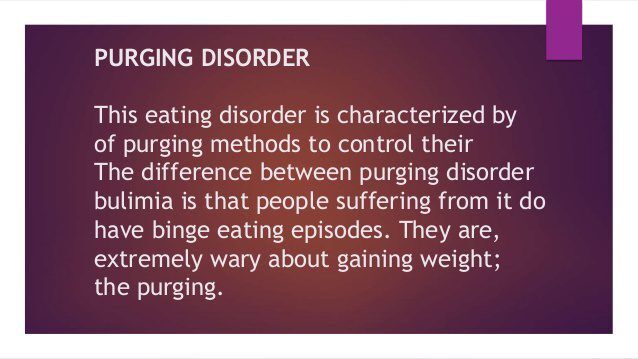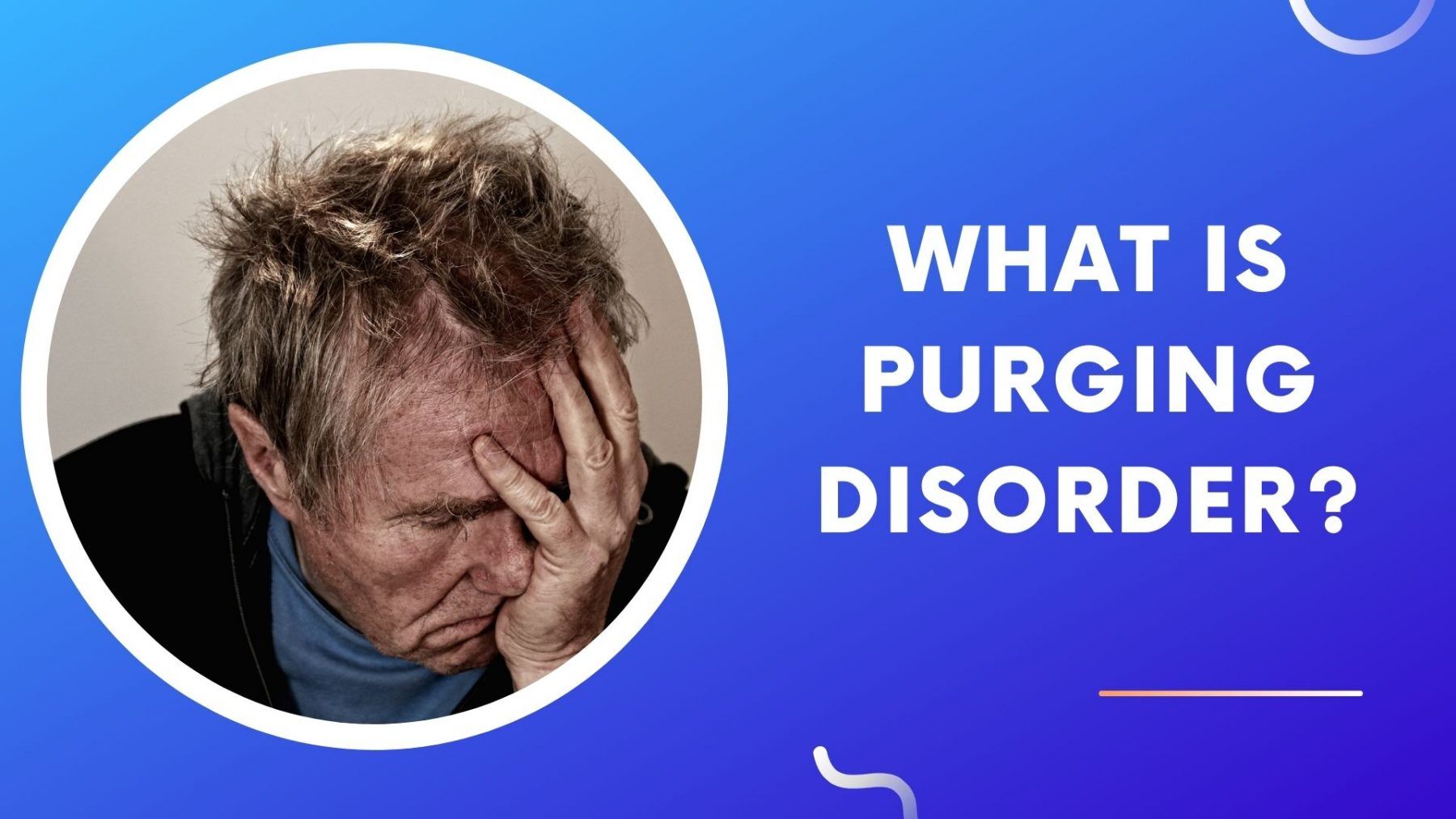Purging disorder is a different type of eating disorder than Bulimia nervosa.
On the surface Bulimia and Purging disorder look very similar. They are both characterized by the recurrent purging of food.
People with either disorder may remove calories from their body using:
- Laxatives
- Diuretics
- Self-induced vomiting
But, there is one key difference.
The main difference between Bulimia nervosa and Purging disorder is binge eating.
In Bulimia, binge eating is present. In Purging disorder, binge eating is not present.
If you’re vomiting or getting rid of calories – but without having binged before – then you have Purging disorder.
If you vomit or get rid of calories after a binge, then you have Bulimia nervosa.
Keep reading if you want to know more about Purging disorder.

Do I Have Purging Disorder?
Here are some of the other symptoms of Purging disorder, besides binge eating.
These symptoms mirror Bulimia because the only difference is binge eating!
- You purge on a regular basis, whether that be by:
- Self-induced vomiting
- Too much exercise
- Laxatives
- Extreme fasting or dieting
- Enemas
- Diuretics
- Extreme weight obsession or incredible fear of gaining weight
- Your weight or body shape determines your self- esteem
- You are anxious during the day and often isolate yourself
Do these eating disorder symptoms sound familiar to you?
Remember if you have these symptoms and you binge eat, then you have what’s called Bulimia. If you don’t binge but still purge, then this is Purging disorder.
Usually people with Purging disorder eat normal amounts of food. Yet you may feel like you are losing control even though you ate a regular amount of food.
You may even feel like you binged! You may feel your belly is full! But in reality you ate a normal amount of food.
This suggests Purging disorder is more mental than is the case with other eating disorders.
A meta-analysis on women with Purging disorder shows distorted perceptions about food.
These women report feeling out of control even though they ate normal-sized portions too!
What Are The Signs Of Purging Disorder?

There are many negative consequences to purging!
Purging affects your body in various ways.
Here are some of the signs and symptoms of purging:
- Scars on the back of your knuckles (because you bite down when purging, also known as Russell’s Sign)
- Facial bloating
- Irregular heart rhythms
- Feeling dizzy
- Teeth enamel wearing away
- Kidney problems
- Dehydration
- Nutritional deficiencies
- Hormonal imbalances
- Problems digesting
- Constipation
- Intense mood swings
How Bad Is Purging and Self-Induced Vomiting?
Purging disorder is very dangerous!
Self-induced vomiting impacts your hydration, heart, and digestion.
If purging is a regular occurrence for a long time then there is higher risk of death. Plus, purging is not even effective for weight loss!
The Bulimia hotline notes: ‘Purging isn’t effective at getting rid of calories, which is why most people suffering with bulimia end up gaining weight over time. Vomiting immediately after eating won’t eliminate more than 50% of the calories consumed— usually much less.’
How Do You Treat Purging / Bulimia Nervosa?
Deciding on how to treat for Purging disorder is complicated.
It’s complicated because there are no randomized studies for Purging disorder treatment. See, Purging disorder was only formally identified in 2005 by Dr. Keel and fellow collaborators.
Even today, Purging disorder isn’t classified by itself but is still considered a Other Specified Feeding Or Eating Disorder (OSFED). (This term means scientists don’t know much about the disorder).
In comparison, Dr. Stunkard first noted Binge Eating Disorder in 1959, although he called the eating disorder ‘night eating’.
So one reason for the lack of scientific research on Purging disorder treatment is the short time frame.
Plus, there aren’t as many people who get diagnosed with Purging disorder. Unfortunately this means scientists have less incentive to study the eating disorder.
But there’s good news!
Eating Disorder Treatments Are Transdiagnostic

Transdiagnostic is a fancy word for ‘treated similarly.’
You treat Anorexia nervosa the same as you treat Bulimia. You treat Bulimia the same as Binge Eating Disorder.
For example, I work as a Recovery Counselor at Cielo House for Eating Disorders. At Cielo our clients struggle primarily with Anorexia nervosa, but we see all types of eating disorders.
But our eating disorder treatment program is nearly identical for all eating disorders. Of course there are different emphasizes depending on each individual client.
But I would say treatment for eating disorders is ‘transdiagnostic’.
This means you can breathe a sigh of relief. It’s likely treatments for other eating disorders work well for Purging disorders too!
In general, Cognitive Behavioral Therapy – Eating Disorder (CBT-E) has shown tremendous promise for Eating Disorders.
CBT-E works with the cognitive mental problems behind Purging disorder.
Treating The Root Cause Of Eating Disorders
It might seem like bingeing, restricting or purging are way different problems. How would eating disorder treatment work across different problems?
Well, turns out there foundational mental factors behind all these problems.
Here are some of the root cognitive factors behind all types of eating disorders:
- A preoccupation with weight or body shape
- Fear of weight gain
- Being obsessed with weight loss
- Having certain triggers which elicit automatic responses, like anxiety being a trigger for eating
- Distorted perceptions about food
- Restrictive rules around food
- Self worth tied up with weight
- Anxiety
- Depression
- History of dieting
- History of trauma
I’m sure you get the point. You treat these underlying cognitive distortions and boom!
The eating disorder starts to go away.
Conclusion: There isn’t a ton of scientific evidence on Purging disorder. But Purging disorder is dangerous. It can be treated with CBT-E. And it is likely other eating disorder treatments apply to Purging disorder as well.


